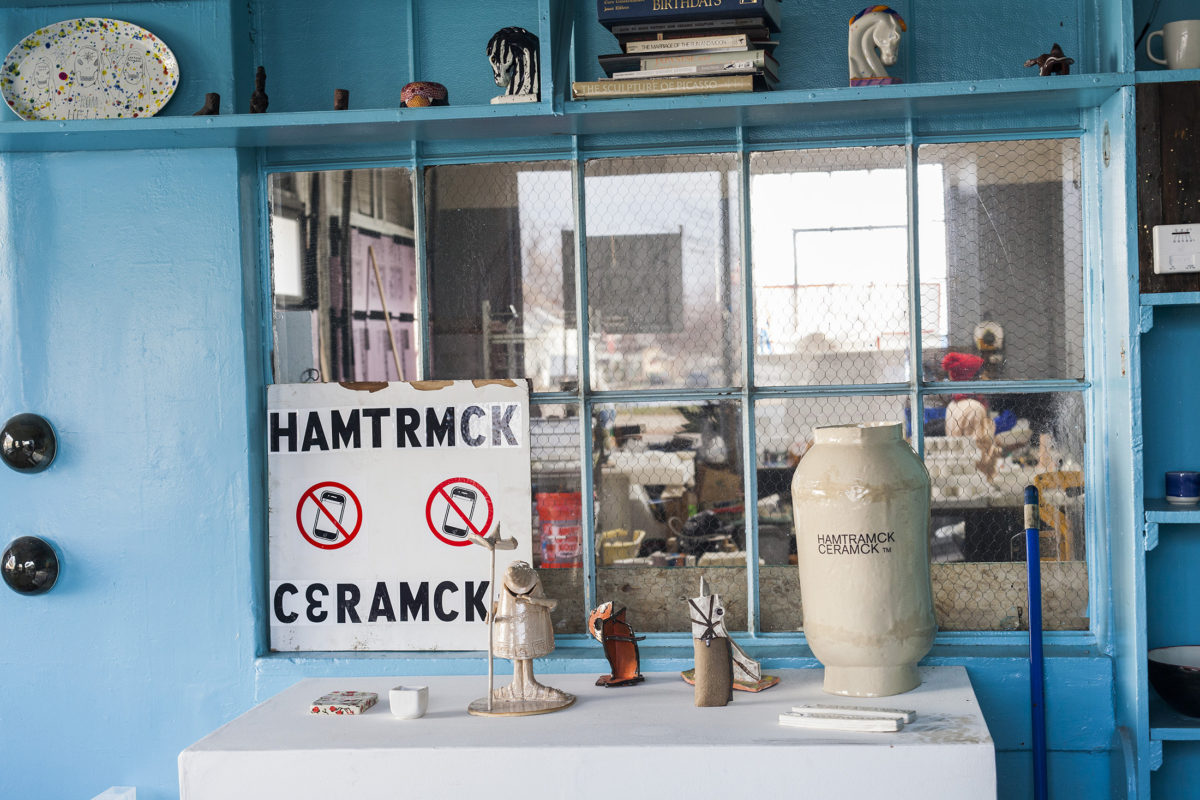Hamtramck Ceramck
Marissa Jezak and Jessica Newberry
Hamtramck Ceramck is an artist collective located at 2060 Norwalk street in Hamtramck, MI. Its members are various and fluctuating, but some current ones include: Amber Locke, Ben Saginaw, Hannah Smith, and Patrick Quinn.
At their studio they make functional & non-functional ceramic artworks using a variety of techniques & experimental processes. We stopped by the garage one cold Fall day to paint fangs and investigate…
Photos by Marissa Jezak.
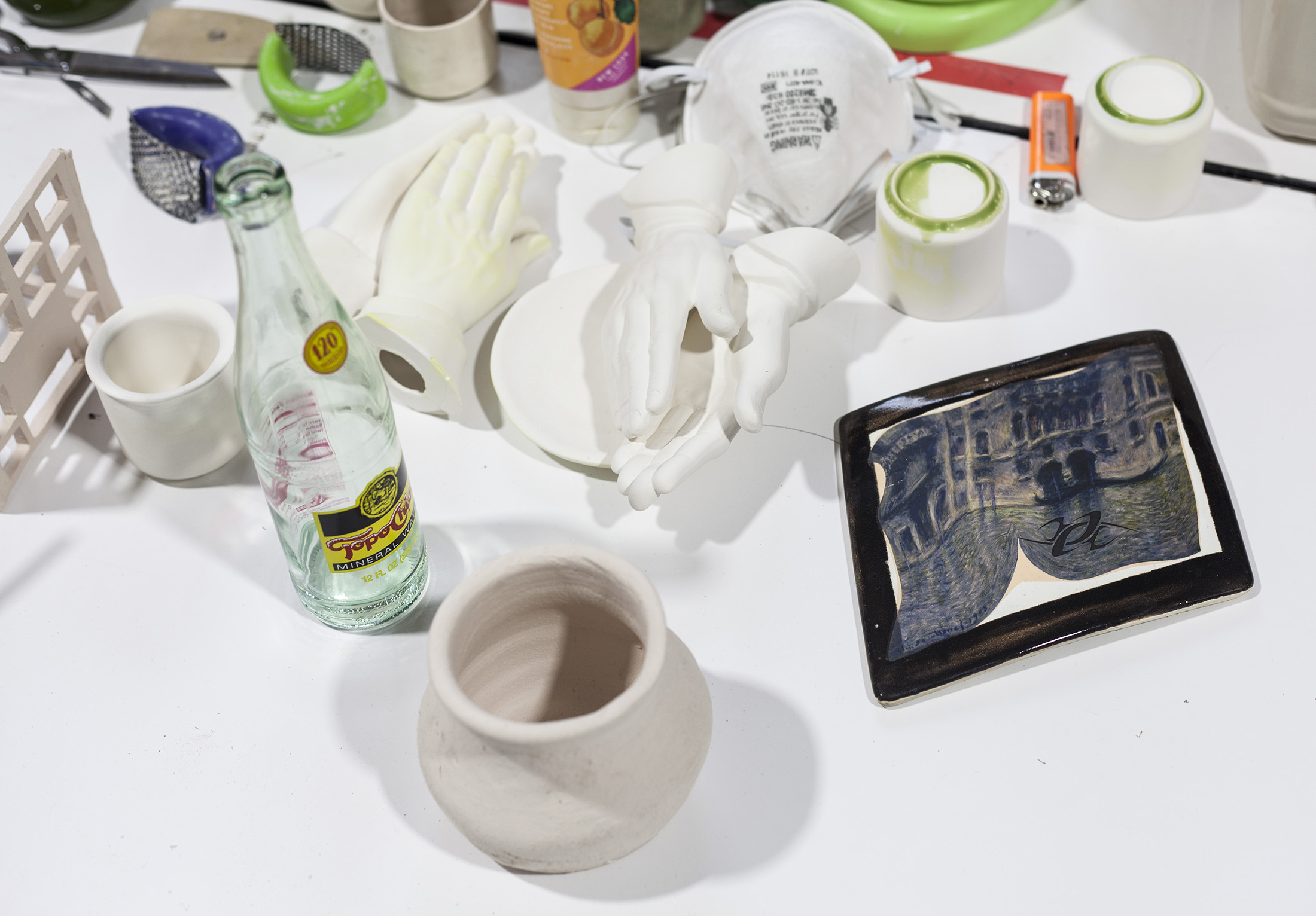
Ben:
We’re still trying to figure out a socialist way of being fair to everyone involved. We would like to be socialist but we understand the reality of existing in a capitalist environment.
Amber:
It’s cool because we’ll have artists, even non-artists come in here just to experiment with like graffiti and weird stuff…
Detroit Research:
Like bring a project in and take it out?
Ben:
We’re still trying to figure out a socialist way of being fair to everyone involved. We would like to be socialist but we understand the reality of existing in a capitalist environment.
Amber:
It’s easy to be antisocial nowadays because of the internet, so it’s a really good way to sit at a table all working on ceramics somehow functioning and working in the same group.
Hannah:
It’s very engaging- like there’s no time when you can be distracted by looking at a laptop or a screen and that’s excellent. We’re really lucky to have that- that carnal sort of sensory material. It’s good to return to that for me, someone who’s worked on the computer for years as an artist.
Ben:
You definitely feel when the energy is high when more members are present and when you’re alone you’re like “damn, where is everybody?” We’ve all had days alone in the studio and it isn’t as fun. It’s rare to have a studio space where everyone’s working in a super contained area and still have it be more functional than if you were alone. There’s a good feeding of energy. It all started in that one little room up there- the bedroom. Then it moved out to the middle room and just expanded to the whole bottom of the house.


Amber:
and there was plaster everywhere.
Ben:
plaster and clay all over the floors. so we finally were like “okay, we’re never gonna pour slip again in the house”…but eventually we’re gonna have to remove the lifts so we can actually have a level floor and move into a situation where we can maintain operations to some degree. But it’s teaching us how to adapt which is fun. We like to do really non-traditional things and are more free in our ability to experiment than most because we don’t have the boundaries that exist around us. The way I make molds would make some one have a heart attack if they were a mold maker.
Amber:
We call it “Ben’s guerrilla mold making.”
Ben:
So it’s like this is us just being like let’s see what happens and obviously that one didn’t work out and l opened the kiln this one day and…it’s a low fire clay that we fired in a Cone 6 glaze and that was much too hot. These used to be bowls and they turned into pancakes.
Amber:
They turned into brownies.
Hannah:
Yeah, it looks really delicious like you kind of want to scrape it off and eat it.
Ben:
But it’s weird like this part here? That’s like a crack so sharp you wouldn’t even realize it. So now they’re basically sculptures.
Amber:
You can still see the painting on it.
Ben:
the dancing people.
Detroit Research:
They’re like Pompeiian.
Amber:
They’re trapped in the heat…pueblo-style, or it’s supposed to be like South American style of painting. Benny was trying to make it look like hatchet man.
Detroit Research:
I was going to ask about objects like that, obviously your work is more non-traditional and there are instances where this is bound to happen and it’s incredible.
Hannah:
I think the biggest thing to me is you really have to let go of your ego because even if you’re the best at ceramics things are always going to go wrong. When I started here I was… my practice is from a really traditional kind of drawing background and I hadn’t done that for a while and everything I was picking up- I was trying to paint all these super detailed images on plates and I don’t even know why, they would just crack in the kiln. So I spent two solid weeks each on a plate and it happened to crack- the first two things I made. So it’s sort of been a lesson of that- like letting go of your ego and knowing that…I don’t know. It’s weird. Sometimes I have ceramic dreams – and I’ll think about something that I’m currently building and remember that I didn’t join something properly and it’ll wake me up.
Detroit Research:
ceramic anxiety?
Hannah:
Yeah, I don’t know if you guys have had it too, it really stays on your mind like that’s right- that slip’s still in the mold. Crap! I have to go. Bye! *just drives away like…The dedication here is so strong. Ben is like the kiln master. We’ll be out partying and he’ll be like “well, it’s 1:00. I’ve gotta go switch the kiln” and he’ll drive off and go flick the switch and come back to the party.
Ben:
It’s fun for me because I never loaded a kiln before but now I get a lot of excitement out of finding the most efficient way to put the most stuff in and make it look cool and I’ll do crazy shit where there will be like levels inside of levels to make more space and that was never part of my life, but now I love loading kilns. Nothing has collapsed yet. We’ve been doing alright. It’s fun too because every obstacle both with the ceramics or emotionally that we encounter- it has become very apparent that the team really helps out every time. And it’s a good support network. It’s like you couldn’t have asked for a better one to deal with every one of those problems because it was all accidental how we all ended up together but it seems very functional how we can- we’ve become very good at troubleshooting emotional problems and being devoted to fixing them which you don’t find a lot. Some people would be like “fuck this”. But every time we step away when we’re mad and we’re like “well, what else would we be doing?” and then we come back. So it’s nice – there’s a familial vibe. It has become more than a friendship and work relationship and we’re really in it til’ the end.
Hannah:
It’s a very emotional thing. It’s like accidentally we’ve all become more emotionally invested than we initially realized, which is natural and great. You want that. You want it to be more than work and involve as much passion as it can. It is definitely that.
Ben:
We all have our different ways of being incredibly crazy and volatile… We’ll take you to the store.
Ben:
So we just hooked up our heater last night or today so now this place isn’t the coldest area.
Amber:
Benny and Pat built these pedestals, scrapped these from an old elementary school (they’re stalls) and carried them in here and then strategically built out shelves to place them on so they’ll fit.
Ben:
So now if we do an offsite event we can just load a car up… It’s a pretty easy way to have a more interesting set up than just a table. Because we’re all visual artists we have this over-intensive fascination with… We’re very devoted to how we visually look as well, not just our product but how it’s presented because we view it, whether it’s a gallery show or not we want it to look very intentional and sometimes that’s where we’ll have different opinions. Sometimes one person will be like a head curator of the event and we thought that was a better way to do it rather than all be secretly moving objects around. (laughing) We should just adopt a philosophy where it will shift and each show will have its own character. You know, I think when we realized that, there was a point where we all had this funny argument and all went away and Hannah was like “I’ll just set everything up” and it was helpful to have concrete direction and not have it be communal too much. It simplifies things but it also changes how the products look. Depending on who the curator would be you have different energy and character to the show. This is pretty much set up by Hannah.
Detroit Research:
So if I asked you which ones are yours there’s not going to be a really clear answer in a lot of cases?
Hannah:
Well no, I would say whose is whose because they’re still individual objects, I think. Like these are Amber’s and these are Amber’s and thats Benny’s.



Hannah:
I think it’s really still important to acknowledge who has made what because our individual styles are definitely present in the works and for instance in the plates- Ben has a very particular style and his influences really show through in his work and Amber’s is also completely different. I think that’s something that they’re trying to navigate. I’m a visiting artist so I’m like looking in.
Detroit Research:
How long are you going to be here?
Hannah:
until the end of December. Then going back to Melbourne. I don’t want to go. I love it here. It’s been really eye-opening for me as an artist to make work in a place I don’t know.
Detroit Research:
What have you learned?
Hannah:
I’ve learned a lot about I guess ego and assistance. A lot has changed for me in the way that I think about the practice of making art now. I think American culture is really good at celebrating success and I’ve been thinking about that a lot since I’ve been here- where people are really proud of what they do and things like that. Australia is like that but people are more shy about how they talk about their work. It’s good being here where people are really confident to talk about who they are and what they do. That’s something I’ve had to learn and it’s been really good for me and taking on a new medium in itself.




Detroit Research:
Do you think you’ll go back and people will be shocked about who you are compared to who you were when you came?
Hannah:
I think they’ll be interested in the shift I’ve made in my work because my work is very different from this. My background recently- I finished a Master’s degree so it was very academic. I’m supposed to continue that line of academia..for me art is about immediacy and present moments in making work. Just to pick up clay and be making stuff- it sounds so basic. With the schooling I had it was like: lay down the concept and then do the work. It’s a return to the root of what I have always actually known and that’s enjoying that immediacy of the medium. I think if you put any group of artists together they will share a vulnerability in their making and it is unique in every group. Working with people in collectives for me feels like the most healthy.
[. . . ]
Detroit Research:
whose hands?
Ben:
I did the white ones, and then the “love and hate” are from the movie Night of the Hunter I believe, and my friend james did those. Also when I did the white ones I learned that stigmata is not on your palm. The nails did not go into your palm. It’s on your wrist. But it makes more sense for that because they’re incense burners. So you put a cone in and it smokes out of the palm. We’ll do the historically accurate stigmata incense burners next. I’ll do one of the right spot. There are a few items that we purchased the molds for. A lot of them we make. We bought the van, the hands, there’s a clock we’ve never used.
Detroit Research:
I like seeing objects that are definitely used for fine art displayed and there’s the whole range between that and more functional and straightforward objects that are going to be used, but they’re all displayed together and all produced together. It doesn’t seem like there’s a great discrimination between the one and the other. Are there moments where you’re definitely working on plates and cups versus…?
Ben:
There are but it’s based on what’s necessary to get done. If we have a job to do, we’ll prioritize it. If we have a task to get done, we’ll do it before the fun stuff. Like I’ve told myself I really want to learn how to throw but I won’t allow myself to do it until our other jobs are done. But that’s just my thing. Amber will be like “I’ll get this done before re-doing the decals for the iPads”… So we do prioritize our time between what’s fun and what isn’t, but it’s all kind of fun. Also there are certain things that we know aren’t functional that we just want to create- they’ll all be in the same kiln together.
[. . . ]
Ben:
Yesterday it was like 45. Cold enough that you wouldn’t want to be in here, and we relocated all of our sanding to Amber’s house last night, and then today we’re doing all of that -so that our space is warm and we’re able to complete all of the jobs. Because otherwise you’re in a situation where you’re torturing yourself, and what isn’t enjoyable becomes so much less. We’re adapting.
Detroit Research:
How often are you here?
Ben:
5-7 days a week. It gets to a point where it’s like what would I rather be doing? Nothing, you know… The best thing I could do is go produce in the studio. George doesn’t make ceramics. He’s a really great chef and eventually will be opening a restaurant in southwest, and we’re probably going to be making a lot of his dishes so he’ll become involved in that. But he just comes and works on his laptop here. Where else would he go? All his friends are here. It’s become a cool meeting place as well as a functioning studio.
Detroit Research:
and non-ceramicists are…
Ben:
Sometimes we’ll draw them in or they’ll be sitting around and we’ll be like “do you want to paint something?”
Amber:
We’re all non-ceramicists, like I don’t really call myself a ceramicist.
[Open studio events hosted monthly] >>>
contact: hamtramckceramck@gmail.com
-
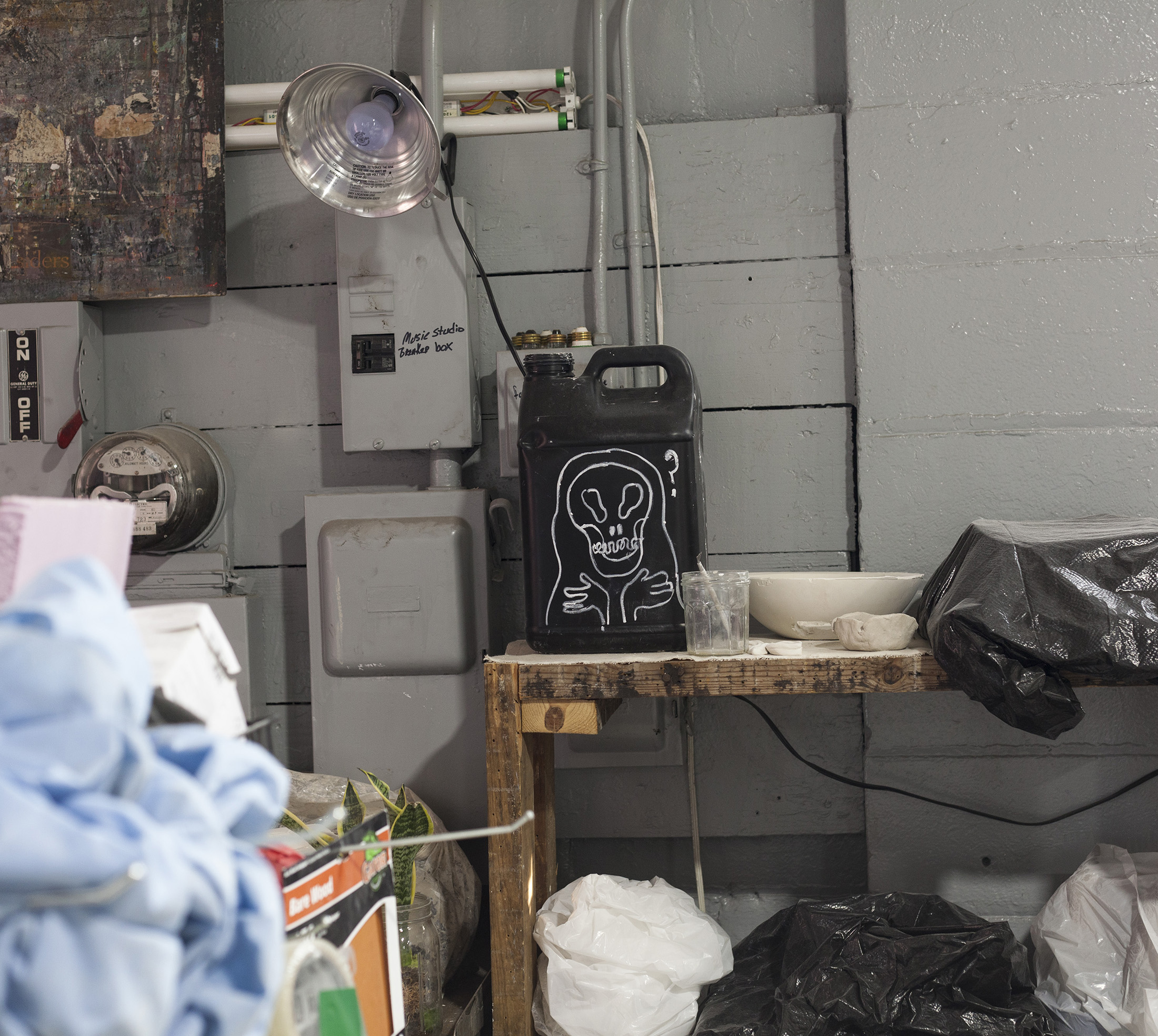 PLAY VIDEO
PLAY VIDEO -
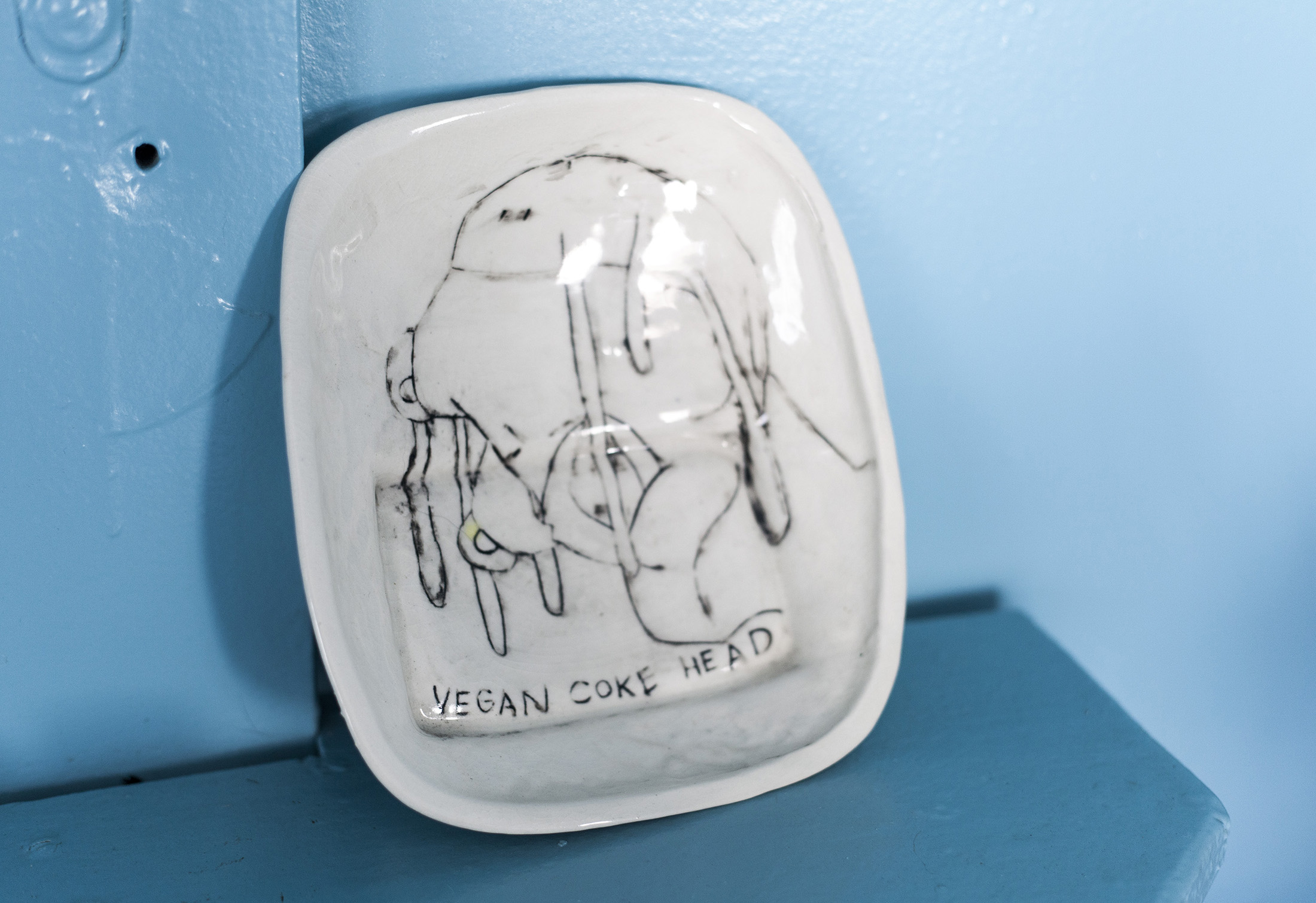 PLAY VIDEO
PLAY VIDEO -
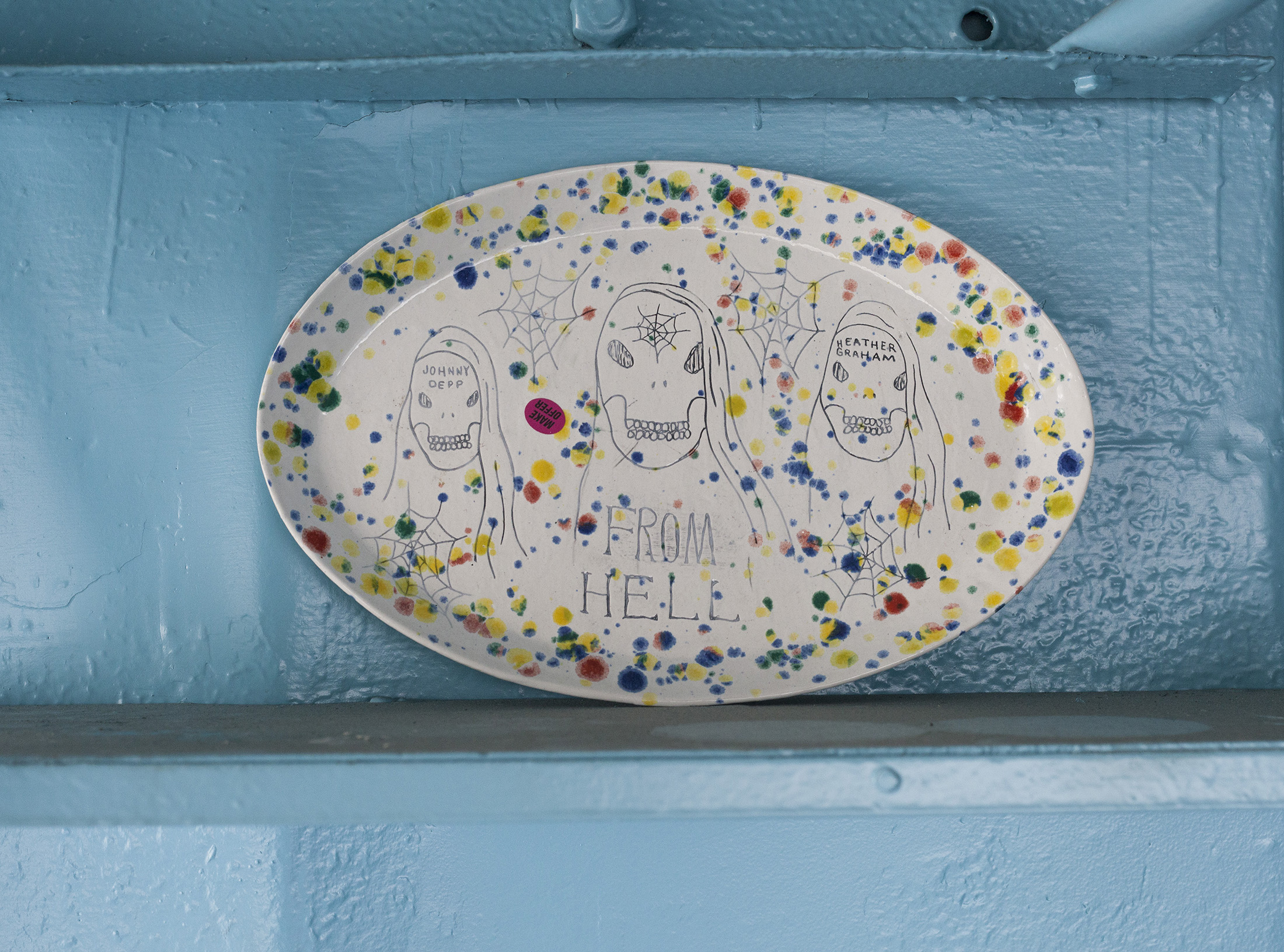 PLAY VIDEO
PLAY VIDEO -
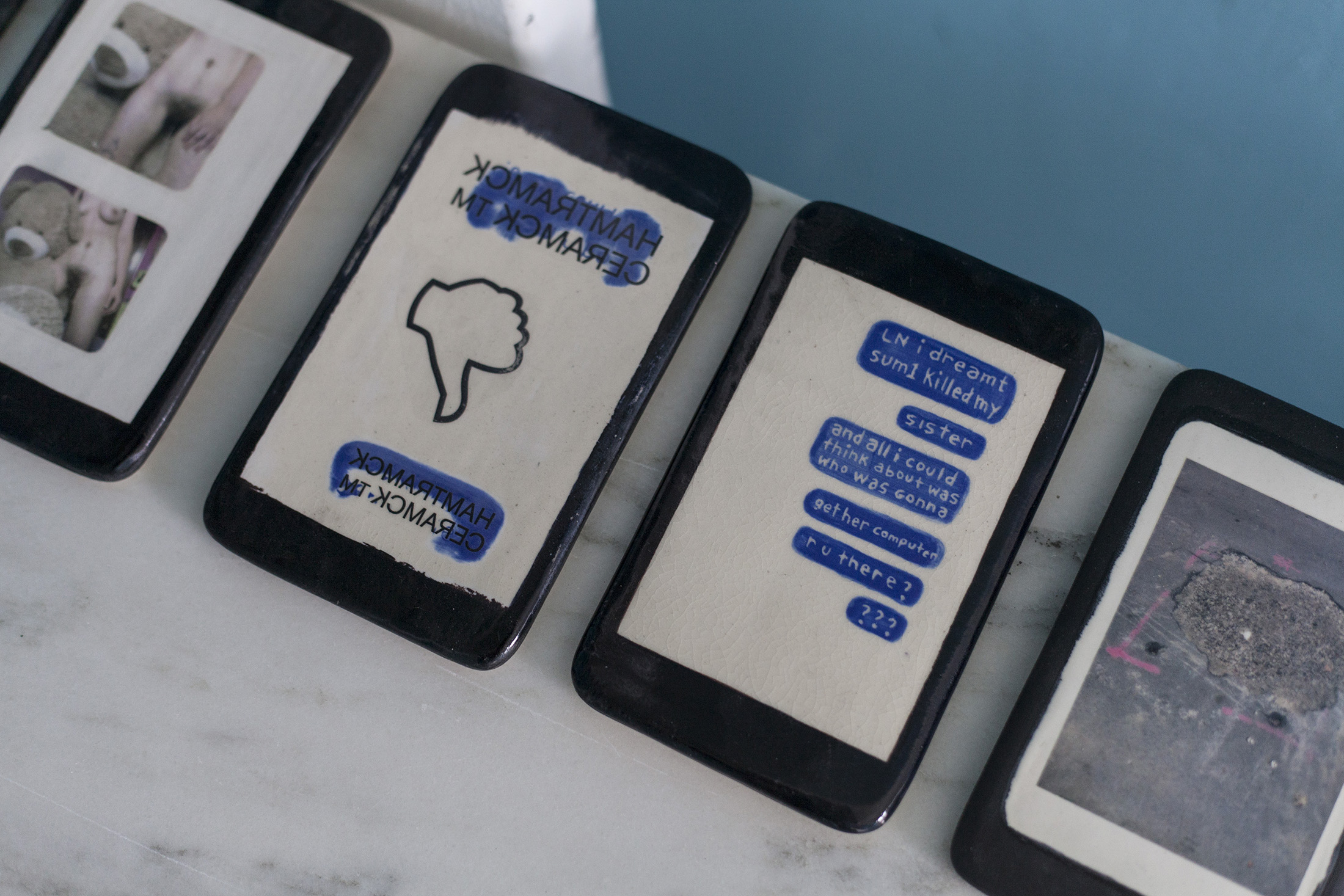 PLAY VIDEO
PLAY VIDEO -
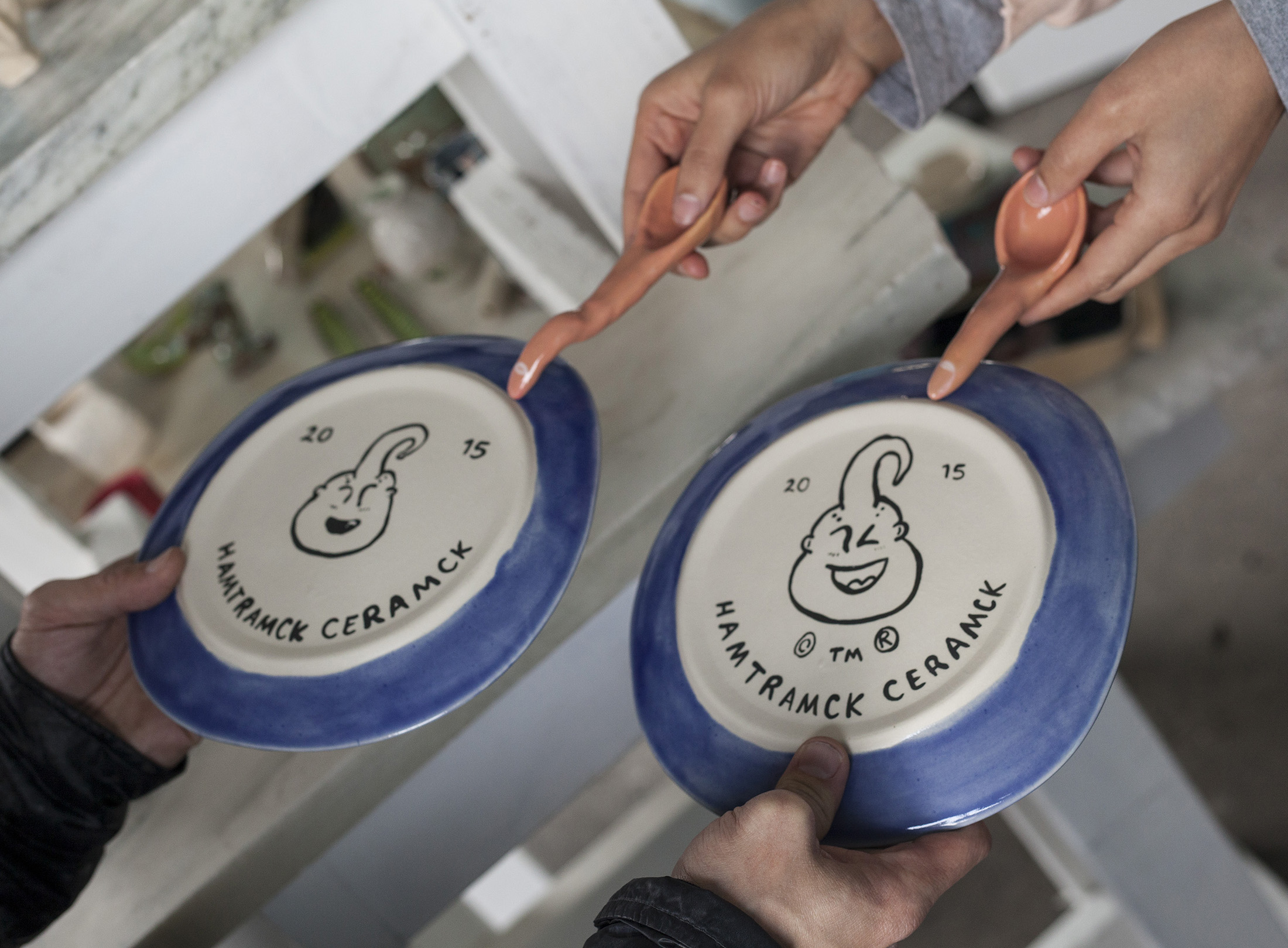 PLAY VIDEO
PLAY VIDEO -
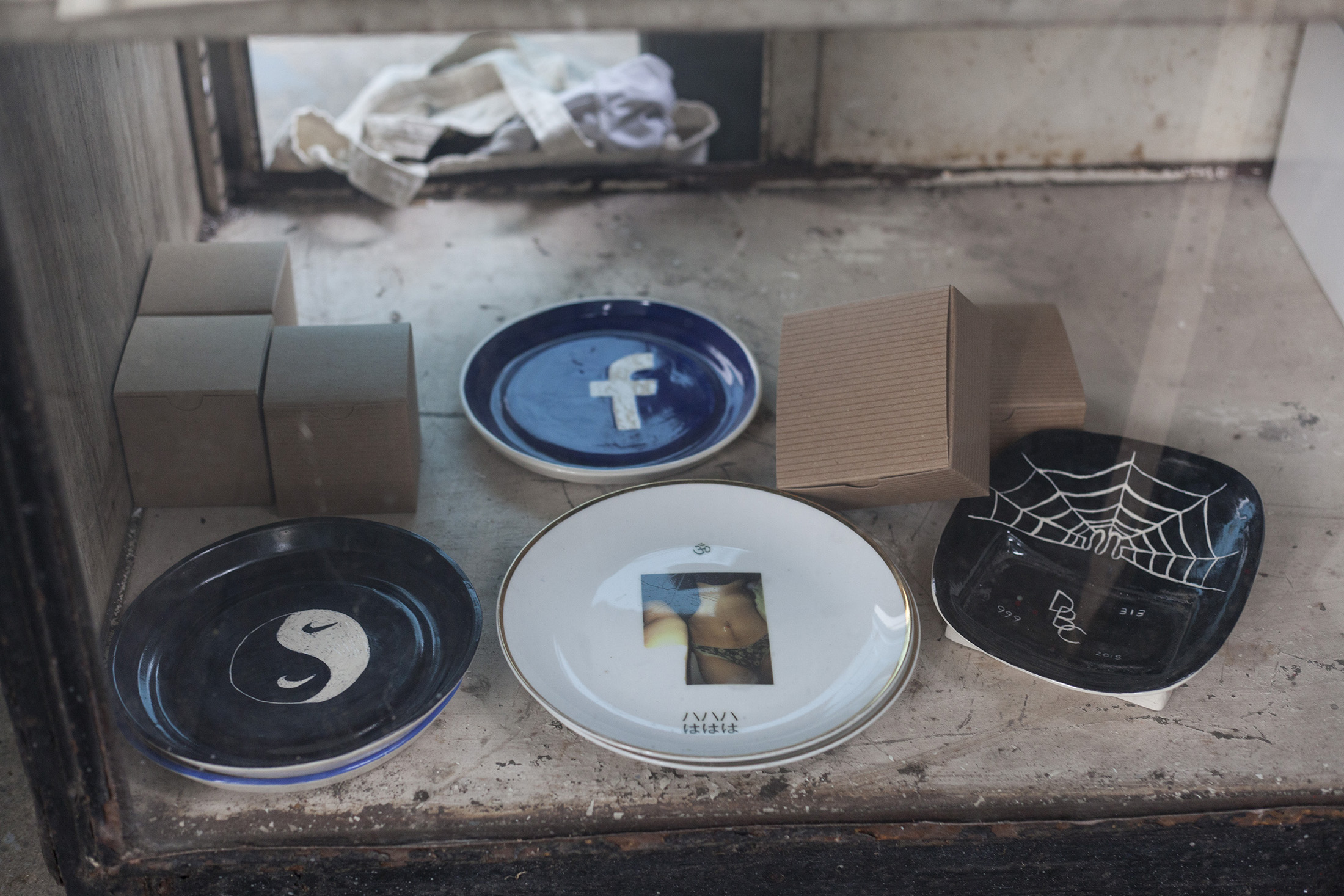 PLAY VIDEO
PLAY VIDEO
